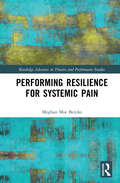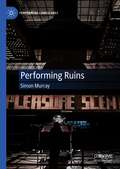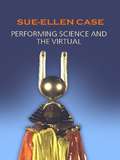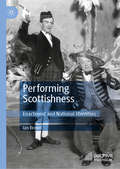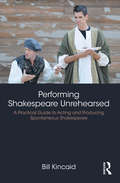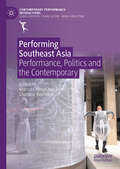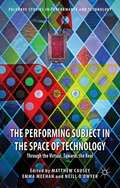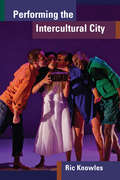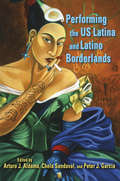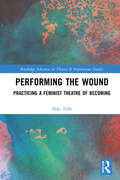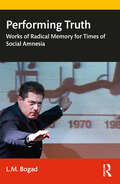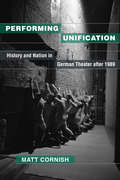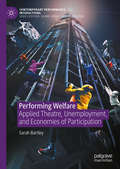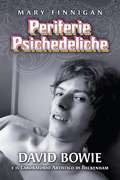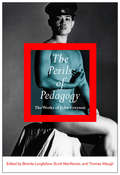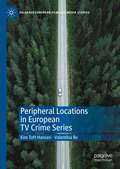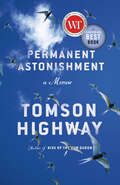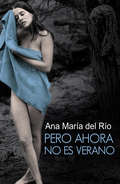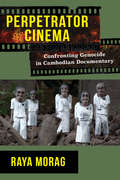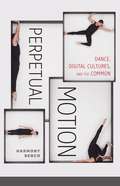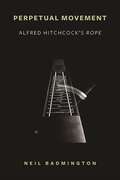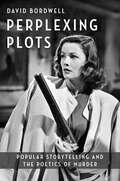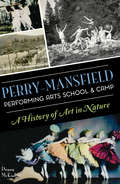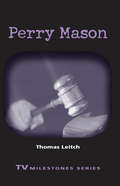- Table View
- List View
Performing Resilience for Systemic Pain (Routledge Advances in Theatre & Performance Studies)
by Meghan Moe BeitiksHow might performance serve as a means for facing ubiquitous trauma and pain, in humans and ecologies? While reflecting on her multidisciplinary work Systems of Pain/Networks of Resilience, artist Meghan Moe Beitiks considers bodies of knowledge in Trauma Theory, Intersectional Feminist Philosophy, Ecology, Disability Studies, New Materialism, Object-Oriented Ontology, Gender Studies, Artistic Research, Psychology, Performance Studies, Social Justice, Performance Philosophy, Performance Art, and a series of first-person interviews in an attempt to answer that question. Beitiks brings us through the first-person process of making the work and the real-life, embodied encounters with the theories explored within it as an expansion of the work itself. Facing down difficult issues like trauma, discrimination, and the vulnerability of the body, Beitiks looks to commonalities across species and disciplines as means of developing resilience and cultivating communities. Rather than paint a picture of glorious potential utopias, Beitiks takes a hard look at herself as an embodiment of the values explored in the work, and stays with the difficult, sucky, troubling, work to be done. Performing Resilience for Systemic Pain is a vulnerable book about the quiet presence and hard looking needed to shift systems away from their oppressive, destructive realities.
Performing Ruins (Performing Landscapes)
by Simon MurrayThis book engages with the relationship between ruins, dilapidation, and abandonment and cultural events performed within such spaces. Following the author’s fieldwork in the UK, Bosnia Herzegovina, Poland, Germany, Greece, and Sicily, chapters describe, investigate, and reflect upon live performance events which have taken place in sites of decay and abandonment. The book’s main focus is upon modern economic ruins and ruins of warfare. Each chapter provides several case studies based upon the author’s own site visits and interviews with actors, directors, producers, curators, writers, and other artists. The book contextualises these events within the wider framework of Ruin Studies and provides brief summaries of how we might understand the ruin in terms of time, politics, culture, and atmospheres. The book is particularly preoccupied with artists’ reasons and motivations for placing performance events in ruined spaces and how these work dramaturgically.
Performing Science and the Virtual
by Sue-Ellen CaseThis impressive new book from Sue-Ellen Case looks at how science has been performed throughout history, tracing a line from nineteenth century alchemy to the twenty-first century virtual avatar. In this bold and wide-ranging book that is written using a crossbreed of styles, we encounter a glance of Edison in his laboratory, enter the soundscape of John Cage and raid tombs with Lara Croft. Case looks at the intersection of science and performance, the academic treatment of classical plays and internet-like bytes on contemporary issues and experiments where the array of performances include: electronic music Sun Ra, the jazz musician the recursive play of tape from Samuel Beckett to Pauline Oliveros Performing Science and the Virtual reviews how well these performances borrow from spiritualist notions of transcendence, as well as the social codes of race, gender and economic exchange. This book will appeal to academics and graduates studying theatre and performance studies, cultural studies and philosophy.
Performing Scottishness: Enactment and National Identities
by Ian BrownThis wide-ranging and ground-breaking book, especially relevant given Brexit and renewed Scottish independence campaigning, provides in-depth analysis of ways Scottishness has been performed and modified over the centuries. Alongside theatre, television, comedy, and film, it explores performativity in public events, Anglo-Scottish relations, language and literary practice, the Scottish diaspora and concepts of nation, borders and hybridity. Following discussion of the 1320 Declaration of Arbroath and the real meanings of the 1706/7 Treaty of Union, it examines the differing perceptions of what the ‘United Kingdom’ means to Scots and English. It contrasts the treatment of Shakespeare and Burns as ‘national bards’ and considers the implications of Scottish scholars’ invention of ‘English Literature’. It engages with Scotland’s language politics –rebutting claims of a ‘Gaelic Gestapo’ – and how borders within Scotland interact. It replaces myths about ‘tartan monsters’ with level-headed evidence before discussing in detail representations of Scottishness in domestic and international media.
Performing Shakespeare Unrehearsed: A Practical Guide to Acting and Producing Spontaneous Shakespeare
by Bill KincaidPerforming Shakespeare Unrehearsed: A Practical Guide to Acting and Producing Spontaneous Shakespeare outlines how Shakespeare’s plays can be performed effectively without rehearsal, if all the actors understand a set of performance guidelines and put them into practice. Each chapter is devoted to a specific guideline, demonstrating through examples how it can be applied to pieces of text from Shakespeare’s First Folio, how it creates blocking and stage business, and how it enhances story clarity. Once the guidelines have been established, practical means of production are discussed, providing the reader with sufficient step-by-step instruction to prepare for Unrehearsed performances. This book is written for the actor and performer.
Performing Southeast Asia: Performance, Politics and the Contemporary (Contemporary Performance InterActions)
by Marcus Cheng Chye Tan Charlene Rajendran"Performing Southeast Asia: Performance, Politics and the Contemporary is an important reconsideration of the histories and practices of theatre and performance in a fluid and dynamic region that is also experiencing an overarching politics of complexity, precarity and populist authoritarian tendencies. In a substantial introductory essay and essays by leading scholars, activists and practitioners working inside the region, the book explores fundamental questions for the arts. The book asks how theatre contributes to and/or addresses the political condition in the contemporary moment, how does it represent the complexity of experiences in peoples’ daily lives and how does theatre engage in forms of political activism and enable a diversity of voices to flourish. The book shows how, in an age of increasingly violent politics, political institutions become sites for bad actors and propaganda. Forces of biopolitics, neo-liberalism and religious and ethnic nationalism intersect in unpredictable ways with decolonial practices – all of which the book argues are forces that define the contemporary moment. Indeed, by putting the focus on contemporary politics in the region alongside the diversity of practices in contemporary theatre, we see a substantial reformation of the idea of the contemporary moment, not as a cosmopolitan and elite artistic practice but as a multivalent agent of change in both aesthetic and political terms. With its focus on community activism and the creative possibilities of the performing arts the region, Performing Southeast Asia, is a timely intervention that brings us to a new understanding of how contemporary Southeast Asia has become a site of contest, struggle and reinvention of the relations between the arts and society." - Peter Eckersall, The Graduate Center, City University of New York, USA "Performing Southeast Asia – with chapters concerned with how regional theatres seek contextually-grounded, yet post-national(istic) forms; how history and tradition shape but do not hold down contemporary theatre; and how, in the editors’ words, such artistic encounters could result in theatres ‘that do not merely attend to matters of cultural heritage, tradition or history, but instead engage overtly with theatre and performance in the contemporary’ – contributes to the possibility of understanding what options for an artistically transubstantiated now-ness may be: to the possibility, that is, of what might be called a ‘Present-Tense Theatre’." - C. J. W.-L. Wee, Professor of English, Nanyang Technological University, SingaporeThis book examines contemporary performance practices and politics in Southeast Asia. It analyses performances created and performed in Southeast Asia, with specific focus on particular nation states, as these engage the volatile or shifting cultures and politics that inform contemporary life, particularly in urban Southeast Asia. In a region haunted historically by political divergence, authoritarianism and militarism, religious diversity and ethnic strife, the chapters reveal how contemporary performance, and performances today reflect yet challenge dominant socio-political discourses. The authors centre their discussion on the efficacies of performance as political intervention in Southeast Asia in a time of seismic socio-political change. They consider issues of state hegemonies, censorship, the resurgence of authoritarianism, the persistence of history and tradition, the impact of finance and sponsorship, social liberalism and conservatism and globalisation and cultural practice.
The Performing Subject in the Space of Technology
by Matthew CauseyNow that the shock of the virtual has subsided toward a 'new-normal' of computational interference in all areas of life, it is an advantageous moment to reflect on the passage through the virtual and back to the real. Digital culture has developed into a bio-virtual environment in which the categories of the biological and the virtual no longer stand as separate. The contributors to this volume respond to the questions raised by the 'after-event' of the digital through practice-led researchanalyses of performance processes, philosophical readings of the work of art and technology, and performance studies investigations of the subject in the spaces of technology. The volume examines a wide range of activities, from bio-art to internet child pornography, gaming and social networking technologies to the use of motion-tracking in developing choreography and documentation. The authors draw from diverse perspectives in dance, theatre, performance, film and music studies, digital arts and culture.
Performing the Intercultural City
by Ric KnowlesIn 1971, Canada became the first country to adopt an official policy of multiculturalism. Performing the Intercultural City explores how Toronto—a representative global city in this multicultural country—stages diversity through its many intercultural theater companies and troupes. The book begins with a theoretical introduction to theatrical interculturalism. Subsequent chapters outline the historical and political context within which intercultural performance takes place; examine the ways in which Indigenous, Filipino, and Afro-Caribbean Canadian theater has developed play structures based on culturally specific forms of expression; and explore the ways that intercultural companies have used intermediality, modernist form, and intercultural discourse to mediate across cultures. Performing the Intercultural City will appeal to scholars, artists, and the theater-going public, including those in theater and performance studies, urban studies, critical multiculturalism studies, diaspora studies, critical cosmopolitanism studies, critical race theory, and cultural studies.
Performing the US Latina and Latino Borderlands
by Arturo J. Aldama Chela Sandoval Peter J. GarcíaIn this interdisciplinary volume, contributors analyze the expression of Latina/o cultural identity through performance. With music theater, dance, visual arts, body art, spoken word, performance activism, fashion, and street theater as points of entry, contributors discuss cultural practices and the fashoning of identity in Latino/a communities throughout the US. Examining the areas of crossover between Latin and American cultures gives new meaning to the notion of "borderlands." This volume features senior scholars and up-and-coming academics from cultural, visual, and performance studies, folklore, and ethnomusicology.
Performing the Wound: Practicing a Feminist Theatre of Becoming (Routledge Advances in Theatre & Performance Studies)
by Niki TulkThis book offers a matrixial, feminist-centered analysis of trauma and performance, through examining the work of three artists: Ann Hamilton, Renée Green, and Cecilia Vicuña. Each artist engages in a multi-media, or “combination” performance practice; this includes the use of site, embodied performance, material elements, film, and writing. Each case study involves traumatic content, including the legacy of slavery, child sexual abuse and environmental degradation; each artist constructs an aesthetic milieu that invites rather than immerses—this allows an audience to have agency, as well as multiple pathways into their engagement with the art. The author Niki Tulk suggests that these works facilitate an audience-performance relationship based on the concept of ethical witnessing/wit(h)nessing, in which viewers are not positioned as voyeurs, nor made to risk re-traumatization by being forced to view traumatic events re-played on stage. This approach also allows agency to the art itself, in that an ethical space is created where the art is not objectified or looked at—but joined with. Foundational to this investigation are the writings of Bracha L. Ettinger, Jill Bennett and Diana Taylor—particularly Ettinger’s concepts of the matrixial, carriance and border-linking. These artists and scholars present a capacity to expand and articulate answers to questions regarding how to make performance that remains compelling and truthful to the trauma experience, but not re-traumatizing. This study will be of great interest to students and scholars of performance studies, art history, visual arts, feminist studies, theatre, film, performance art, postcolonialism, rhetoric and writing.
Performing Truth: Works of Radical Memory for Times of Social Amnesia
by L.M. BogadPerforming Truth answers the most pressing questions facing any theatre-makers who are wrestling with how to present historical, political or socioeconomic information in an engaging, entertaining, and galvanizing way. How to make data compelling and documents mobilizing? How to keep an audience interested in what might be dry, dire, or depressing? How to surprise an audience and keep them alert? Collecting together the performance texts of international performance artist and activist L.M. Bogad, this book accompanies each script with essays that further explore that work's performance strategies. It also equips readers with specific resources and pedagogical tools to help those wishing to stage these pieces or create their own work to engage with similar topics. Bogad also provides "takeaways" for each piece, illustrating the challenges of its particular subject matter and how to overcome those challenges with innovations unique to performance art. This is a key guidebook for artists and theatre-makers facing the challenges of engaging with information in an era of fake news, propaganda bots, and the polarization of ideological spheres, as well as students and teachers taking on that challenge in theatre studies, performance studies and performing arts classrooms.
Performing Unification: History and Nation in German Theater after 1989
by Matt CornishSince the moment after the fall of the Berlin Wall in 1989, the most important German theater artists have created plays and productions about unification. Some have challenged how German history is written, while others opposed the very act of storytelling. Performing Unification examines how German directors, playwrights, and theater groups including Heiner Müller, Frank Castorf, and Rimini Protokoll have represented and misrepresented the past, confronting their nation’s history and collective identity. While scholars and critics have scrutinized unification in cinema and literature, this is the first book to focus on theater and performance. Author Matt Cornish surveys German-language history plays from the Baroque period through Friedrich Schiller, Heinrich von Kleist, Brecht, and up to the documentary theater movement of the 1960s to show how German identity has always been contested, even well before Germany became a nation. Then turning to performances of unification after 1989, Cornish argues that theater, in its structures and its live gestures, on pages, stages, and streets, helps us to understand the past and its effect on us, our relationships with others in our communities, and our futures. Engaging with theater theory from Aristotle through Bertolt Brecht and Hans-Thies Lehmann’s “postdramatic” theater, and also with theories of history from Hegel to Walter Benjamin and Hayden White, Performing Unification demonstrates that historiography and dramaturgy are intertwined.
Performing Welfare: Applied Theatre, Unemployment, and Economies of Participation (Contemporary Performance InterActions)
by Sarah BartleyThis book explores what happens to socially committed performance when state systems of social security are dismantled. Since 2010, a punishing programme of economic austerity and a seismic overhaul of the Welfare State in the United Kingdom has been accompanied by an ideological assault on dependency; a pervasive scapegoating of the poor, young, and disabled; and an intensification of the discursive relationship between morality and work. This book considers the artistic, material, and ideological consequences of such shifts for applied and socially engaged performance. Performing Welfare reveals how such arts practices might reconstitute notions of work and labour in socially constructive ways. It focuses on the political potential of participation during a period in which classifications of labour and productivity are intensely contested. It examines the migration of discourses from state policy to the cultural sector; narratives of community and aesthetics of dependency; the paradoxes of visibility in creative projects with stigmatised participants; the implicit relationship of participatory performance to neoliberal productivity; and, the parallels between gendered divisions of labour, social reproduction, and applied performance. It will appeal to students, scholars, and practitioners interested in applied and socially engaged performance, participation, community, representation, the welfare state, social policy, labour, and unemployment.
Periferie Psichedeliche
by Andrea Giampaoli Mary FinniganDavid Bowie ha ispirato decine di biografie sul suo genio musicale, ma nessuna mai così ricca di particolari - e di foto inedite - come quella degli esordi dell’artista nella periferia londinese raccontanti dalla giornalista Mary Finnigan in Psychedelic Suburbia – David Bowie and The Beckenham Arts Lab, pubblicato da Jorvik Press . É la storia di un giovanissimo Bowie, ancora sconosciuto, in cerca di ingaggi per concerti nei club di Londra. Mary Finnigan racconta di averlo accolto nella sua casa nel quartiere londinese di Beckenham, sostenendolo economicamente e di esserne divenuta la sua amante. Insieme fondarono un folk club al pub Three Tuns di Beckenham, organizzando riunioni settimanali alle quali man mano partecipavano sempre più persone tra poeti, studenti di cinema e altri creativi. Il club divenne un vero e proprio laboratorio artistico, The Beckenham Arts Lab, tra arti visive, teatro, poesia e musica, una Factory proprio come quella che stava creando Andy Warhol a New York. Il tutto culminerà nel Free Festival del 1696, evento che Bowie canterà nella famosa canzone "Memory of a Free Festival". Traduzione a cura di Andrea Giampaoli
The Perils of Pedagogy: The Works of John Greyson
by Brenda Longfellow Scott MacKenzie Thomas WaughWhether addressing HIV/AIDS, the policing of bathroom sex, censorship, or anti-globalization movements, John Greyson has imbued his work with cutting humour, eroticism, and postmodern aesthetics. Mashing up high art, opera, community activism, and pop culture, Greyson challenges his audience to consider new ways that images can intervene in both political and public spheres. Emerging on the Toronto scene in the late 1970s, Greyson has produced an eclectic, provocative, and award-winning body of work in film and video. The essays in The Perils of Pedagogy range from personal meditations to provocative textual readings to studies of the historical contexts in which the artist's works intervened politically as well as artistically. Notable writers from a range of disciplines as well as prominent experimental and activist filmmakers tackle questions of documentary ethics, moving image activism, and queer coalitional politics raised by Greyson's work. Close to one hundred frame captures and stills from almost sixty works, along with articles, speeches, and short scripts by Greyson - several never before published - supplement the collection. Celebrating thirty years of passionate, brilliant, and affecting moviemaking, The Perils of Pedagogy will fascinate both specialists and general readers interested in media activism and advocacy, censorship, and freedom of expression.
The Perils of Pedagogy
by Scott Mackenzie Brenda Longfellow Thomas WaughWhether addressing HIV/AIDS, the policing of bathroom sex, censorship, or anti-globalization movements, John Greyson has imbued his work with cutting humour, eroticism, and postmodern aesthetics. Mashing up high art, opera, community activism, and pop culture, Greyson challenges his audience to consider new ways that images can intervene in both political and public spheres. Emerging on the Toronto scene in the late 1970s, Greyson has produced an eclectic, provocative, and award-winning body of work in film and video. The essays in The Perils of Pedagogy range from personal meditations to provocative textual readings to studies of the historical contexts in which the artist's works intervened politically as well as artistically. Notable writers from a range of disciplines as well as prominent experimental and activist filmmakers tackle questions of documentary ethics, moving image activism, and queer coalitional politics raised by Greyson's work. Close to one hundred frame captures and stills from almost sixty works, along with articles, speeches, and short scripts by Greyson - several never before published - supplement the collection. Celebrating thirty years of passionate, brilliant, and affecting moviemaking, The Perils of Pedagogy will fascinate both specialists and general readers interested in media activism and advocacy, censorship, and freedom of expression.
Peripheral Locations in European TV Crime Series (Palgrave European Film and Media Studies)
by Kim Toft Hansen Valentina ReThis book is a comprehensive study of peripheral locations in contemporary European TV crime series. Ambitiously, it covers the complete geography of Europe, and offers a nuanced image of a changing, dynamic, and unfinished continent. The chapters include analyses of the practical, creative approach to producing crime series in European peripheries and rural areas, evaluating a continent marked by an internal crisis between urban and rural Europe. The study includes readings of crime series such as Shetland, Bitter Daisies, Trom, Pagan Peak, and The Border, but presents such representative cases within broader tendencies on the European TV market, including challenges from streaming services, the influence of Nordic Noir, and changes within the cognitive geography of Europe. The authors position peripheral European crime series in a complex relationship between universal appeal and local recognisability and offer a comprehensive theoretical approach to the aesthetics of peripherality. Grounded in desktop production studies, the book presents an original scholarly approach to analysing European crime series from a continental point of view. Despite local differences, the spatio-generic orientations scrutinized in the book – Nordic Noir, Mediterranean Noir, Country Noir, Eastern Noir, and Brit Noir – show remarkable aesthetic similarities in series from territories otherwise normally unconnected in television production. Consequently, television crime series reveal a common tongue and voice for dialogue on a continent in a deepening crisis.
Permanent Astonishment: A Memoir
by Tomson HighwayCapricious, big-hearted, joyful: an epic memoir from one of Canada&’s most acclaimed Indigenous writers and performersTomson Highway was born in a snowbank on an island in the sub-Arctic, the eleventh of twelve children in a nomadic, caribou-hunting Cree family. Growing up in a land of ten thousand lakes and islands, Tomson relished being pulled by dogsled beneath a night sky alive with stars, sucking the juices from roasted muskrat tails, and singing country music songs with his impossibly beautiful older sister and her teenaged friends. Surrounded by the love of his family and the vast, mesmerizing landscape they called home, his was in many ways an idyllic far-north childhood. But five of Tomson's siblings died in childhood, and Balazee and Joe Highway, who loved their surviving children profoundly, wanted their two youngest sons, Tomson and Rene, to enjoy opportunities as big as the world. And so when Tomson was six, he was flown south by float plane to attend a residential school. A year later Rene joined him to begin the rest of their education. In 1990 Rene Highway, a world-renowned dancer, died of an AIDS-related illness. Permanent Astonishment: Growing Up in the Land of Snow and Sky is Tomson's extravagant embrace of his younger brother's final words: "Don't mourn me, be joyful." His memoir offers insights, both hilarious and profound, into the Cree experience of culture, conquest, and survival.
Pero ahora no es verano
by Ana María Del RíoComo todos los años, la casa de Mallara es más grande de lo que yo creía. Aérea, no parece afirmarse sobre base terrestre alguna, sino que se ve como si brotara del suelo, elevándose como una brusca espiga súbita sobre sus cuatro pisos. Es el tiempo de la reforma agraria y los campesinos se han tomado los caminos. Nadie entra ni sale de los confines del campo, que parece hundirse en el barro que todo lo cubre. La tragedia ronda en este singular y no poco mordaz fin de mundo. Pero ahora no es verano, una novela de amor y de prejuicios, nos conduce con enorme talento literario por derroteros de pasión, inocencia y traición.
Perpetrator Cinema: Confronting Genocide in Cambodian Documentary (Nonfictions)
by Raya MoragPerpetrator Cinema explores a new trend in the cinematic depiction of genocide that has emerged in Cambodian documentary in the late twentieth- and early twenty-first centuries. While past films documenting the Holocaust and genocides in Yugoslavia, Rwanda, and elsewhere have focused on collecting and foregrounding the testimony of survivors and victims, the intimate horror of the autogenocide enables post–Khmer Rouge Cambodian documentarians to propose a direct confrontation between the first-generation survivor and the perpetrator of genocide. These films break with Western tradition and disrupt the political view that reconciliation is the only legitimate response to atrocities of the past. Rather, transcending the perpetrator’s typical denial or partial confession, this extraordinary form of “duel” documentary creates confrontational tension and opens up the possibility of a transformation in power relations, allowing viewers to access feelings of moral resentment.Raya Morag examines works by Rithy Panh, Rob Lemkin and Thet Sambath, and Lida Chan and Guillaume Suon, among others, to uncover the ways in which filmmakers endeavor to allow the survivors’ moral status and courage to guide viewers to a new, more complete understanding of the processes of coming to terms with the past. These documentaries show how moral resentment becomes a way to experience, symbolize, judge, and finally incorporate evil into a system of ethics. Morag’s analysis reveals how perpetrator cinema provides new epistemic tools and propels the recent social-cultural-psychological shift from the era of the witness to the era of the perpetrator.
Perpetual Motion: Dance, Digital Cultures, and the Common (Electronic Mediations #59)
by Harmony BenchA new exploration of how digital media assert the relevance of dance in a wired world How has the Internet changed dance? Dance performances can now be seen anywhere, can be looped endlessly at user whim, and can integrate crowds in unprecedented ways. Dance practices are evolving to explore these new possibilities. In Perpetual Motion, Harmony Bench argues that dance is a vital part of civil society and a means for building participation and community. She looks at how, after 9/11, it became a crucial way of recuperating the common character of public spaces. She explores how crowdsourcing dance contributes to the project of performing a common world, as well as the social relationships forged when we look at dance as a gift in the era of globalization. Throughout, she asks how dance brings people together in digital spaces and what dance&’s digital travels might mean for how we experience and express community. From original research on dance today to political economies of digital media to the philosophy of dance, Perpetual Motion provides an ambitious, invigorating look at a commonly shared practice.
Perpetual Movement: Alfred Hitchcock's Rope (SUNY series, Horizons of Cinema)
by Neil BadmingtonThe first book-length study in English of Alfred Hitchcock's Rope (1948), Perpetual Movement offers both a production history that draws extensively upon little-known archival materials, including set drawings and drafts of the screenplay, and a close examination of the film in which Neil Badmington analyzes each of Rope's eleven shots. Writing in an accessible and engaging style, Badmington explores the film's treatment of space, sound, editing, sexuality, source material, design, intertexuality, narrative, and music. He looks at Hitchcock's struggle with censorship while planning, shooting, and distributing the film. Perpetual Movement also addresses Rope's reception and legacy, explaining why the film's unusual qualities provide such lasting appeal for viewers.
Perplexing Plots: Popular Storytelling and the Poetics of Murder (Film and Culture Series)
by David BordwellNarrative innovation is typically seen as the domain of the avant-garde. However, techniques such as nonlinear timelines, multiple points of view, and unreliable narration have long been part of American popular culture. How did forms and styles once regarded as “difficult” become familiar to audiences?In Perplexing Plots, David Bordwell reveals how crime fiction, plays, and films made unconventional narrative mainstream. He shows that since the nineteenth century, detective stories and suspense thrillers have allowed ambitious storytellers to experiment with narrative. Tales of crime and mystery became a training ground where audiences learned to appreciate artifice. These genres demand a sophisticated awareness of storytelling conventions: they play games with narrative form and toy with audience expectations. Bordwell examines how writers and directors have pushed, pulled, and collaborated with their audiences to change popular storytelling. He explores the plot engineering of figures such as Raymond Chandler, Agatha Christie, Dashiell Hammett, Patricia Highsmith, Alfred Hitchcock, Dorothy Sayers, and Quentin Tarantino, and traces how mainstream storytellers and modernist experimenters influenced one another’s work. A sweeping, kaleidoscopic account written in a lively, conversational style, Perplexing Plots offers an ambitious new understanding of how movies, literature, theater, and popular culture have evolved over the past century.
Perry-Mansfield Performing Arts School & Camp: A History of Art in Nature (Landmarks)
by Dagny MckinleyIn 1914, Charlotte Perry and Portia Mansfield envisioned a secluded institution nestled in the mountains, where art and nature could intersect. By the 1920s, their remote Perry-Mansfield Performing Arts School & Camp in Steamboat Springs was serving as a hub for top dancers such as José Limon and Harriette Ann Gray to hone their craft. In addition to training thousands of pointed toes and arched feet, the school showcased equestrian jumping and performed plays by masters, including Shakespeare, García Lorca and Tennessee Williams. The theater program eventually attracted budding actors like Julie Harris, Dustin Hoffman and Jessica Biel. Author Dagny McKinley presents the story of America’s longest continuously running performing arts camp.
Perry Mason: Perry Mason
by Thomas LeitchAn exploration of the enduring popularity of the television series Perry Mason and its universal reputation as the most formulaic program in the history of broadcast television.
